Pesticide Manufacturing and Storage
Pesticide Pollution
Estimated Population at Risk:
730,000
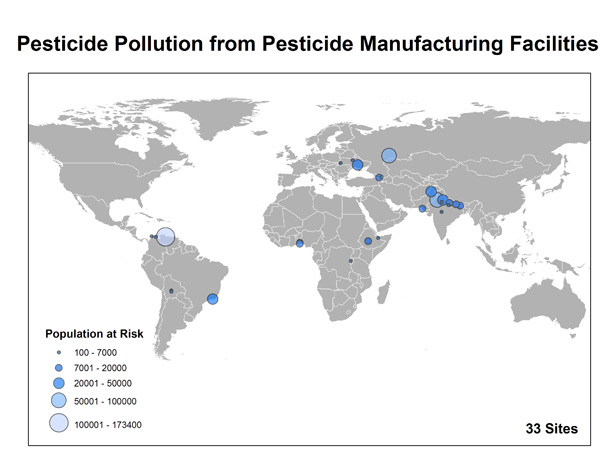
Populations estimates are preliminary and based on an ongoing global assessment of known polluted sites.
Description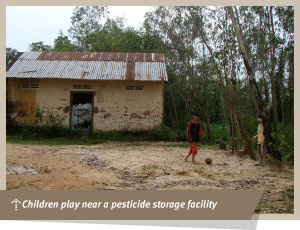 Pesticides are widely used in agricultural processes throughout the world in order to protect crops from pests, fungus, and bacteria, but many of these materials have been found to pose such a health hazard that they have been banned under the Stockholm Convention or are considered Highly Hazardous under the Basel Convention. However, though the international community has taken great lengths to protect people and the environment from particularly hazardous pesticides, many of these products continue to be produced, used, and stored. Some of the more noxious, banned pesticides that can still be found in high quantities in storage facilities are carbamates, persistent organic pollutants, organophosphates, and organochlorines – which include DDT and chlordane.
Pesticides are widely used in agricultural processes throughout the world in order to protect crops from pests, fungus, and bacteria, but many of these materials have been found to pose such a health hazard that they have been banned under the Stockholm Convention or are considered Highly Hazardous under the Basel Convention. However, though the international community has taken great lengths to protect people and the environment from particularly hazardous pesticides, many of these products continue to be produced, used, and stored. Some of the more noxious, banned pesticides that can still be found in high quantities in storage facilities are carbamates, persistent organic pollutants, organophosphates, and organochlorines – which include DDT and chlordane.
Many of the facilities that currently house large stockpiles of hazardous pesticides are very old or dilapidated and do not have proper infrastructures to support safe storage of the chemicals. In many of these facilities, old and deteriorating drums of toxins are stored in the open where they can leak into the surrounding environment. Because numerous pesticide storage areas were built many years ago, urban centers have since sprung up around them, leaving dangerous toxins in close proximity to residential neighborhoods. Other pesticides have been buried on site or in landfills, some of them to be excavated later and sold on black markets.
Industrial Process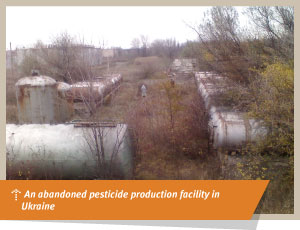 While a significant amount of toxic exposure to pesticides is due to improper storage, the pesticide manufacturing process itself can also release contaminants into surrounding areas.
While a significant amount of toxic exposure to pesticides is due to improper storage, the pesticide manufacturing process itself can also release contaminants into surrounding areas.
Though there are over 1,600 active ingredients that are used to create hundreds thousands of different kinds of pesticides. The basic method of creating pesticides consists of a manufacturing step and a formulation step. The manufacturing process involves the creation of a chemical reaction between two or more compounds in order to create an active ingredient.55 The formulation stage consists of mixing active ingredients with solvents and other materials in order to produce different forms of pesticides for various application purposes such as sprays or powders.56 The processes that occur within each of these steps can potentially create toxic emissions, effluents, or solid wastes, especially if proper safety precautions are not taken.57
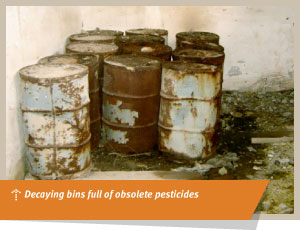 Global Context
Global Context
A large majority of storage facilities containing outdated, banned pesticides – many of which are abandoned – exist in low- and middle-income countries. In many places, these stocks of pesticides continue to be sold, despite being classified as hazardous and deemed illegal for use, and farmers frequently buy them due to their affordability and a lack of understanding about the health risks posed by these toxins. A 1996 study conducted by the Food and Agriculture Organization of the United Nations reported that approximately 15,000 to 20,000 tons of obsolete pesticides were still being stored in Africa.58 This number is dwarfed again by estimates for the area of the Former Soviet Union, where numbers go into the hundreds of thousands of tons.59 According Blacksmith’s research, the largest problems posed by pesticide storage and manufacturing are in India, Russia, Pakistan, and various countries in Central Asia, with affected populations approximating over 700,000 people. The main banned pesticide that is found in many of these places is DDT, but in terms of volume, lindane wastes will be the largest challenge in the future.

Exposure Pathways
The largest threat from pesticide manufacturing and storage is caused by old and improper storage containers and facilities that allow concentrated levels of toxins to leak into the environment. These leaks can carry toxins from the facilities directly into nearby soil and water that may be used for bathing, drinking, or agriculture. Once toxins from pesticides enter the soil, they can also easily travel as dust on shoes or clothing and can be inhaled, touched, or ingested.
Some pesticides are persistent toxins and can have very long life spans once they enter the environment. Pesticides can also bio-accumulate in the tissue of animals. DDT in food is particularly hazardous and can build up in humans because of its solubility in body fat.
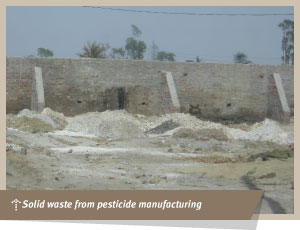 Health Effects
Health Effects
Though there are many different kinds of pesticides, each with different and varying levels of human health risk, pesticide storage poses a particular health problem due to the amounts of banned and dangerous pesticide stocks that still exist. DDT, for example, can lead to problems for kidneys, liver, intestines, the stomach, and the central nervous system, and can also cause cancer. If children or pregnant women are exposed, DDT may be responsible for reproductive and developmental problems.
What is Being Done
Significant international programs have been put in place to begin the reduction and clean up of pesticide stocks, with positive results. One multilateral effort, the Africa Stockpiles Programme, has been implemented in South Africa, Morocco, Nigeria, Tunisia, Mali, Tanzania, and Ethiopia.
Green Cross Switzerland works closely with FAO, UNEP and WHO in the area of the Former Soviet Union and in West-Africa to raise awareness on the risks of old and obsolete pesticides, find and safeguard old pesticides, introduce better practices in future pesticides management, and introduce (non-chemical) alternatives to DDT to control malaria in Central Asia and the Caucasus.
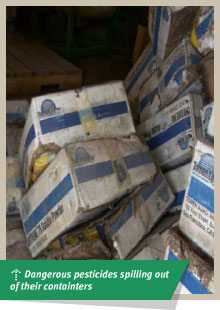 Example – DALY Calculations
Example – DALY Calculations
A DDT factory in the northwest of Pakistan was closed in 1994 due to the banning of the pesticide. While the factory was in operation it produced up to 6,000 tons of DDT per year, and large stockpiles of the toxin are still stored at this abandoned facility. High levels of DDT can still be found in water and soil around the facility, and samples found 573 parts per million of DDT in soil, which is over 60 times the health standard. Blacksmith estimates that 40,000 people are at risk of health problems from DDT exposure in this area.
DALYs associated with health issues from DDT exposure are estimated to be 5,637 for an exposed population of 40,000 people. Thus, the 40,000 affected people will have a collective 5,637 years lost to death, or impacted by disease or disability. This comes out to 0.1 years lost or lived with a disability per person.
Footnotes:
[55]: “Pesticide Industry: A Profile – Draft Report.” Research Triangle Institute. Prepared for the U.S. Environmental Protection Agency, December 1993.
Available at: http://www.epa.gov/ttnecas1/regdata/IPs/Agricultural%20Chemicals%20(pesticides)_IP.pdf.
[56]: “Pesticide Industry: A Profile – Draft Report.” Research Triangle Institute. Prepared for the U.S. Environmental Protection Agency, December 1993.
Available at: http://www.epa.gov/ttnecas1/regdata/IPs/Agricultural%20Chemicals%20(pesticides)_IP.pdf.
[57]: “Environmental Guidelines for Pesticides Manufacturing.” Multilateral Investment Guarantee Agency, World Bank. Available at: http://www.miga.org/documents/PesticidesManufacturing.pdf.
[58]: Wodagene, A. and H. van der Wulp. “Obsolete Pesticides in Developing Nations.” Pesticides News, No. 32 (1996): 12-13.
[59]: See: http://www.ihpa.info/how-to-be-involved/how-big-is-the-problem/.

-
Artisanal Gold Mining
Mercury Pollution
-
Industrial Estates
Lead Pollution
-
Agricultural Production
Pesticide Pollution
-
Lead Smelting
Lead Pollution
-
Tannery Operations
Chromium Pollution
-
Mining and Ore Processing
Mercury Pollution
-
Mining and Ore Processing
Lead Pollution
-
Lead-Acid Battery Recycling
Lead Pollution
-
Arsenic in Groundwater
Arsenic Pollution
-
Pesticide Manufacturing and Storage
Pesticide Pollution
-
The Rest of the Toxic Twenty



